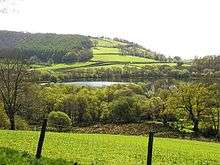Talley Lakes
Upper Talley Lake and Lower Talley Lake (Welsh: Llyn Talyllychau Uchaf and Llyn Talyllychau Isaf[1]) are two small lakes immediately north of the village of Talley, 7 miles (11 km) north of Llandeilo in Carmarthenshire, Wales. They are protected as a Site of Special Scientific Interest.

Morphology
The lakes occupy a glacial hollow that formed during the last ice age, the intervening ground being formed from hummocky glacial deposits.[2] Lower Talley Lake to the north is almost 16 acres (6.5 ha) and Upper Talley Lake to the south is 27 acres (11 ha).[3]
History
The earthworks of a Norman motte-and-bailey castle occupy the neck of land between the two lakes. The remains of the castle motte (mound) are 30 metres (98 ft) in diameter and 4 metres (13 ft) high and would have originally have been topped by a timber framed defensive tower. The surrounding bailey would have enclosed the lord's hall and related buildings. The castle probably fell out of use when Talley Abbey was established.[4]
Talley Abbey is immediately to the south of the upper lake, and was founded between 1184 and 1189.[5] The monks used the lakes for farming fish. The abbey was dissolved in the sixteenth century and is now a ruin.
Natural history
The lower lake is surrounded by alder and willow woods and is not easily accessible. It is used by overwintering wildfowl. The upper lake is more open[3] and can be seen from the B4302 road.
Great crested grebes and mute swans regularly breed on the reserve. Regular visiting birds include tufted ducks, pochards, goldeneye ducks and goosanders.[3]
Water plants in the lower lake include yellow and white water lilies and water crowfoot. This is the most southerly British location of the water sedge.[3]
Invertebrates in the reserve include water beetles and the leaf beetle Donacia obscura. Dragonflies are commonly seen including the emperor dragonfly.[3]
See also
- List of Sites of Special Scientific Interest in Carmarthen & Dinefwr
References
- Fernandez, Carles-Enric (2012). Legends of the Lakes of Wales: Thematic Classification and Analysis (PDF) (MA). University of Wales Trinity Saint David. Retrieved 25 April 2020.
- "Geology of Britain viewer". British Geological Survey. Retrieved 25 April 2020.
- "Talley Lakes, Llandeilo, Carmarthenshire". The Wildlife Trust of South & West Wales. Retrieved 6 April 2019.
- "Talley Mound − Castle Earthworks". Coflein. Royal Commission on the Ancient and Historical Monuments of Wales. Retrieved 6 April 2019.
- "Talley Abbey;Abbey of the Blessed Virgin and St John the Baptist, Talley". Coflein. Royal Commission on the Ancient and Historical Monuments of Wales. Retrieved 6 April 2019.
- Davies, Jonathan Ceredig (1911). Folk-Lore of West and Mid-Wales. Aberystwyth. p. 308. OCLC 559408253. Retrieved 25 April 2020.